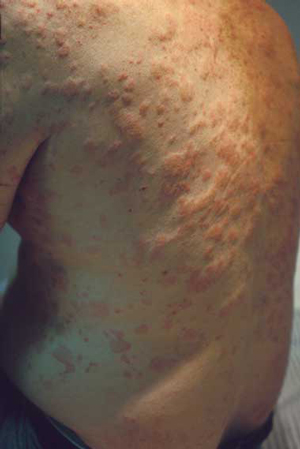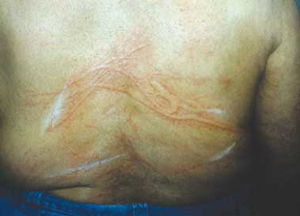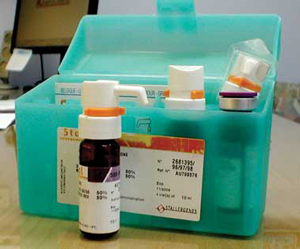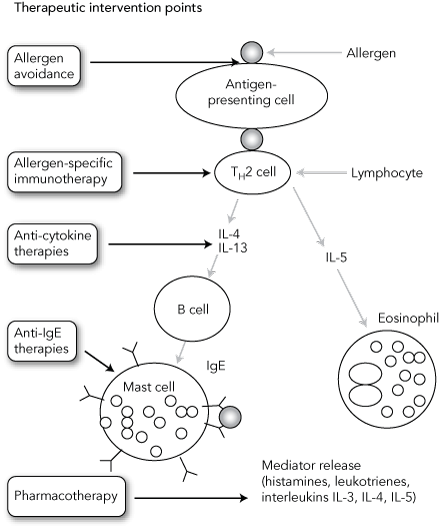IgE is produced by B lymphocytes directed by cytokine release from T helper (TH) lymphocytes (Box 1). In people with allergies, the TH lymphocytes secrete cytokines that stimulate the production of IgE antibodies to allergens. The condition of secreting IgE in response to common environmental allergens is called “atopy”. Predisposition to atopy is determined by both genetic and environmental influences, particularly in infancy, when immune responses to allergens are maturing, and T lymphocyte cytokine production is influenced by environmental exposures.
The manifestation of allergic diseases changes throughout life: food allergies and eczema are most likely to develop in infants, asthma in young children, and rhinitis in older children and adults (Box 2).1 There is increasing evidence that appropriate treatment of allergies can prevent and alter the natural history of allergic diseases. Optimal treatment requires accurate determination of allergic triggers. Moreover, if an allergen avoidance strategy is to be pursued in relation to food or aeroallergens, it is critical to minimise the inconvenience of this strategy by making a correct diagnosis as early as possible.
Skin prick testing relies on the introduction of a very small amount of allergen extract into the epidermis using a standardised method to ensure reproducibility and comparability of results (Box 3). The results of skin prick testing are read at 10 minutes (for the positive control [histamine dihydrochloride or codeine]) and 15 minutes (for the allergen), and the diameter of the resulting weal is recorded in two dimensions. By convention, a positive test is one in which the mean of the two weal diameters is at least 3 mm greater than the negative control (saline), although if the reaction is as small as this, the relevance of the response is in question. Positive and negative controls are critical to enable interpretation of test results.2
When performed correctly, skin prick testing with aeroallergens (eg, house dust mite allergen, pollens, domestic pet allergens) shows good correlation with blood specific IgE testing in a semi-quantitative manner.3 However, careful patient selection for skin prick testing is critical for both safety and interpretation: absolute and relative contraindications to skin prick testing are listed in Box 4.
Doctors wishing to conduct skin prick testing should refer to specific guidelines for conducting skin prick tests.2 Standardised conduct of testing is critical to identifying the relevant allergens, and interpretation of the results is equally critical. Where feasible, the requesting doctor should observe the patient’s skin prick tests to aid interpretation.
Accurate diagnosis of the allergens responsible for allergic disease presents therapeutic opportunities for allergen-specific therapies such as allergen avoidance and immunotherapy (Box 5 and Box 6).
However, allergen avoidance is particularly contentious when applied to the area of aeroallergens and respiratory allergic disease. People who are clearly allergic to animal allergens (eg, cat allergens) are generally not troubled by the allergy unless they encounter the animal, providing a strong case for allergen avoidance. Similarly, to give an example from the health care environment, avoidance of powdered latex gloves has been effective in reducing symptomatic latex allergy and the incidence of new cases in hospital staff.5 But the situation is less clear with respect to house dust mite allergen, the most common domestic allergen in Australia. While older trials of allergen avoidance suggested that it reduced asthma symptoms, bronchial reactivity and eczema, two recent studies in patients with asthma6 and rhinitis,7 confirmed by a meta-analysis,8 question these benefits and suggest that further studies of secondary treatment of asthma by allergen avoidance are unlikely to prove that the method is effective.
So, what should the treating doctor recommend? The evidence suggests that house dust mite avoidance should be recommended cautiously, if at all, and certainly only in people with clear sensitivity to house dust mite allergen. In symptomatic animal allergy, there is some evidence that removal from the home of a pet to which a person is allergic significantly reduces allergic symptoms and medication requirements.9 Although it is intuitively reasonable to reduce relevant allergen exposure in people with allergic symptoms, recent studies challenge the effectiveness of universal allergen avoidance strategies for allergies to domestic allergens.
Allergen-specific immunotherapy involves administration of increasing doses of allergen to a patient to achieve clinical and immunological tolerance over time. Allergen injection immunotherapy induces T cell tolerance by several methods, including decreased allergen-induced proliferation, alteration of secreted cytokines, stimulation of apoptosis, and the production of T regulatory cells. This results in a reduction in inflammatory cells and mediators in the affected tissues, the production of blocking antibodies, and the suppression of IgE.10
The only absolute indication for immunotherapy is in patients who develop systemic reactions to insect venom, in whom incremental subcutaneous doses of venom can achieve tolerance to insect stings in 80%–90% of cases.11 However, immunotherapy for stinging insect sensitivity needs to be continued for at least 5 years to achieve durable tolerance.12 Conventional (subcutaneous) immunotherapy for allergic respiratory disease is clearly effective compared with placebo and requires 3 or more years of treatment to obtain durable efficacy.
Subcutaneous immunotherapy is very effective for seasonal allergic rhinitis caused by grass pollens. It has been shown in some studies to reduce symptoms by over 60%.13 While not first-line treatment for asthma, allergen immunotherapy has been shown to be effective in reducing airway responsiveness and exacerbation rates.14 Although the benefits of subcutaneous immunotherapy are apparent in both asthma and allergic rhinitis, the use of immunotherapy needs to be balanced against the inconvenience of its delivery and the risks associated with anaphylaxis due to allergen administration.
More recently, allergen immunotherapy for aeroallergens has been delivered by sublingual/swallow immunotherapy (SLIT). Meta-analysis of the many trials of this form of treatment confirms its safety and efficacy,15 but there are insufficient trials comparing sublingual immunotherapy with subcutaneous immunotherapy to compare similar dosing regimens. Moreover, efficacy with some allergens and in children is still under debate. However, if its efficacy for a broad range of allergens is proven, sublingual immunotherapy offers treatment that is probably more acceptable to patients and parents than subcutaneous immunotherapy. The major current drawback of sublingual immunotherapy is cost, as allergen doses required for effective treatment are at least 100-fold greater than those needed for subcutaneous immunotherapy. This translates into medication costs at least three times higher than for subcutaneous therapy. Poor patient adherence to prolonged courses of sublingual treatment may also be a factor reducing effectiveness.
There are also promising reports of sublingual immunotherapy for food allergies. While this approach needs to be further confirmed in extensive studies, and will need to be performed in specialist centres because of its high risk, this is a promising avenue of treatment for food allergy — an area in which current treatment relies on long-term avoidance for secondary prevention.16
“What can I do to prevent allergic diseases in my children?” This is a very common question asked by parents. Although there has been much conjecture on how to influence the infantile immune response to reduce the likelihood of allergen sensitisation and subsequent allergic disease, effective specific preventive therapies have not yet been developed. Nevertheless, the following recommendations all have some evidence of efficacy in preventing either allergen sensitisation or disease such as wheeze or eczema, or both, especially in children born to high-risk families.17
Exclusive breastfeeding to 4–6 months of age;
Use of hydrolysed milk formulas for babies unable to be breastfed; and
Quitting smoking.
Fact or fiction — true or false?
1. Nearly all true allergic reactions are mediated by IgE (T/F)
2. A positive skin prick test always indicates an allergy (T/F)
3. Allergen immunotherapy is an effective method of treating and preventing asthma (T/F)
4. Avoidance of house dust mites is always indicated in childhood asthma (T/F)
3. True. There is extensive evidence that allergen immunotherapy is effective in asthma treatment,14 and emerging evidence suggests that it may prevent the development of asthma in children with rhinitis.
More relevant to primary prevention are large trials of multifactorial interventions, such as the Canadian Childhood Asthma Primary Prevention Study18 and the Australian Childhood Asthma Prevention Study.19 The Canadian study, which has now been going for 7 years, shows a significant odds ratio (0.39) for the prevention of current asthma in a cohort of high-risk children as a result of a multifaceted intervention that has included encouragement of breastfeeding and avoidance of house dust, pets and tobacco smoke. The results of other similar trials, and data demonstrating the durability of benefits, will be needed to formulate public health measures in this direction.
In addition to allergen avoidance in the presence of established disease, allergen-specific treatments can be used to reduce the development of allergic disease in sensitised individuals. Subcutaneous allergen immunotherapy has been shown to halve the rate of subsequent development of asthma in children with seasonal allergic rhinitis, indicating that allergen immunotherapy may have particular benefits in these children.20 Sublingual immunotherapy may also offer promise in reducing asthma onset in children with both perennial and seasonal rhinitis and asthma.21 Also, daily antihistamine treatment of children with eczema has been shown to reduce rates of asthma in those with grass pollen allergy.22
Researchers into allergen immunotherapy continue to seek safer and more convenient allergy “vaccines”.23 Peptide therapies based on the T lymphocyte epitopes of allergens offer hope in this area, but their clinical utility is yet to be demonstrated for all but cat allergy.24 Other approaches to allergic disease have been the development of humanised monoclonal anti-IgE antibodies, which have been found to have some efficacy in treating asthma25 and food allergies.26 Anti-IgE treatments may offer therapeutic opportunities for people with multiple sensitivities. Anti-cytokine therapies have also been investigated to treat asthma. Anti-interleukin-5 therapy has produced some reduction in inflammation, but has failed to improve bronchial hyper-responsiveness.27 Early trials of tumour necrosis factor alpha (TNF-α) blocking have shown some success, but further work is needed on specific blockers in inflammatory pathways.28
4 Skin prick testing
Skin prick testing is contraindicated if:
A diffuse dermatological condition is present. Testing must be performed on normal healthy skin.
Severe dermatographism is present.
Patient cooperation is poor.
The patient is unable to stop using drugs that may interfere with the test result.
Skin prick testing is inadvisable if:
Persistent severe or unstable asthma is present.
There is a severe initial reaction (anaphylaxis).
The patient is pregnant.
The patient is taking certain types of drugs:
Antihistamines, tricyclic antidepressants, some antinauseants, and topical steroids (but not oral steroids) can interfere with results;
β-blockers and angiotensin-converting enzyme inhibitors should be used with caution.
6 Evidence-based practice tips*
Allergen immunotherapy is an effective treatment for stinging insect allergy, allergic rhinitis and asthma (Level I).
Avoidance of house dust mites cannot be currently recommended to improve asthma or rhinitis (Level I).
Stopping smoking in the home and when pregnant is an effective way of reducing respiratory disease in children (Level II).
* Based on National Health and Medical Research Council levels of evidence.4
- Jo A Douglass1,2
- Robyn E O’Hehir1,2
- 1 Department of Allergy, Immunology and Respiratory Medicine, Alfred Hospital, Melbourne, VIC.
- 2 Department of Medicine, Monash University, Melbourne, VIC.
Jo Douglass and Robyn O’Hehir have received funding from GlaxoSmithKline and AstraZeneca to attend international meetings.
- 1. Spergel JM. Atopic march: link to upper airways. Curr Opin Allergy Clin Immunol 2005; 5: 17-21.
- 2. Skin tests used in type I allergy testing. Position paper. Sub-Committee on Skin Tests of the European Academy of Allergology and Clinical Immunology. Allergy 1989; 44 Suppl 10: 1-59.
- 3. Wood RA, Phipatanakul W, Hamilton RG, Eggleston PA. A comparison of skin prick tests, intradermal skin tests, and RASTs in the diagnosis of cat allergy. J Allergy Clin Immunol 1999; 103 (5 Pt 1): 773-779.
- 4. National Health and Medical Research Council. How to use the evidence: assessment and application of scientific evidence. Canberra: NHMRC, 2000. http://www.nhmrc.gov.au/publications/_files/cp69.pdf (accessed Jul 2006).
- 5. Latza U, Haamann F, Baur X. Effectiveness of a nationwide interdisciplinary preventive programme for latex allergy. Int Arch Occup Environ Health 2005; 78: 394-402.
- 6. Woodcock A, Forster L, Matthews E, et al; Medical Research Council General Practice Research Framework. Control of exposure to mite allergen and allergen-impermeable bed covers for adults with asthma. N Engl J Med 2003; 349: 225-236.
- 7. Terreehorst I, Hak E, Oosting AJ, et al. Evaluation of impermeable covers for bedding in patients with allergic rhinitis. N Engl J Med 2003; 349: 237-246.
- 8. Gøtzsche PC, Johansen HK, Schmidt LM, Burr ML. House dust mite control measures for asthma. Cochrane Database Syst Rev 2004; (4): CD001187.
- 9. Shirai T, Matsui T, Suzuki K, Chida K. Effect of pet removal on pet allergic asthma. Chest 2005; 127: 1565-1571.
- 10. Gardner LM, Thien FC, Douglass JA, et al. Induction of T “regulatory” cells by standardized house dust mite immunotherapy: an increase in CD4+ CD25+ interleukin-10+ T cells expressing peripheral tissue trafficking markers. Clin Exp Allergy 2004; 34: 1209-1219.
- 11. Westall GP, Thien FCK, Czarny D, et al. Adverse events associated with rush Hymenoptera venom immunotherapy. Med J Aust 2001; 174: 227-230. <MJA full text>
- 12. Moffitt JE, Golden DB, Reisman RE, et al. Stinging insect hypersensitivity: a practice parameter update. J Allergy Clin Immunol 2004; 114: 869-886.
- 13. Plaut M, Valentine MD. Clinical practice. Allergic rhinitis. N Engl J Med 2005; 353: 1934-1944.
- 14. Abramson MJ, Puy RM, Weiner JM. Allergen immunotherapy for asthma. Cochrane Database Syst Rev 2003; (4): CD001186.
- 15. Wilson DR, Lima MT, Durham SR. Sublingual immunotherapy for allergic rhinitis: systematic review and meta-analysis. Allergy 2005; 60: 4-12.
- 16. Enrique E, Pineda F, Malek T, et al. Sublingual immunotherapy for hazelnut food allergy: a randomized, double-blind, placebo-controlled study with a standardized hazelnut extract. J Allergy Clin Immunol 2005; 116: 1073-1079.
- 17. Prescott SL, Tang MLK. The Australasian Society of Clinical Immunology and Allergy position statement: summary of allergy prevention in children. Med J Aust 2005; 182: 464-467. <MJA full text>
- 18. Chan-Yeung M, Ferguson A, Watson W, et al. The Canadian Childhood Asthma Primary Prevention Study: outcomes at 7 years of age. J Allergy Clin Immunol 2005; 116: 49-55.
- 19. Peat JK, Mihrshahi S, Kemp AS, et al. Childhood Asthma Prevention Study. Eighteen-month outcomes of house dust mite avoidance and dietary fatty acid modification in the Childhood Asthma Prevention Study (CAPS). J Allergy Clin Immunol 2004; 114: 807-813.
- 20. Moller C, Dreborg S, Ferdousi HA, et al. Pollen immunotherapy reduces the development of asthma in children with seasonal rhinoconjunctivitis (the PAT-study). J Allergy Clin Immunol 2002; 109: 251-256.
- 21. Novembre E, Galli E, Landi F, et al. Coseasonal sublingual immunotherapy reduces the development of asthma in children with allergic rhinoconjunctivitis. J Allergy Clin Immunol 2004; 114: 851-857.
- 22. Warner JO; ETAC Study Group. Early treatment of the atopic child. A double-blinded, randomized, placebo-controlled trial of cetirizine in preventing the onset of asthma in children with atopic dermatitis: 18 months’ treatment and 18 months’ posttreatment follow-up. J Allergy Clin Immunol 2001; 108: 929-937.
- 23. Gardner L, O’Hehir RE, Rolland JM. T-cell targeted allergen derivatives for improved efficacy and safety of specific immunotherapy for allergic disease. Curr Med Chem 2003; 2: 351-365.
- 24. Alexander C, Tarzi M, Larche M, Kay AB. The effect of Fel d 1-derived T-cell peptides on upper and lower airway outcome measurements in cat-allergic subjects. Allergy 2005; 60: 1269-1274.
- 25. Niebauer K, Dewilde S, Fox-Rushby J, Revicki DA. Impact of omalizumab on quality-of-life outcomes in patients with moderate-to-severe allergic asthma. Ann Allergy Asthma Immunol 2006; 96: 316-326.
- 26. Leung DY, Sampson HA, Yunginger JW, et al; Avon Longitudinal Study of Parents and Children Study Team. Effect of anti-IgE therapy in patients with peanut allergy. N Engl J Med 2003; 348: 986-993.
- 27. Flood-Page P, Menzies-Gow A, Phipps S, et al. Anti-IL-5 treatment reduces deposition of ECM proteins in the bronchial subepithelial basement membrane of mild atopic asthmatics. J Clin Invest 2003; 112: 1029-1036.
- 28. Berry MA, Hargadon B, Shelley M, et al. Evidence of a role of tumor necrosis factor alpha in refractory asthma. N Engl J Med 2006; 354: 697-708.











Abstract
Allergy is defined as an immune-mediated inflammatory response to common environmental allergens that are otherwise harmless.
The diagnosis of allergy is dependent on a history of symptoms on exposure to an allergen together with the detection of allergen-specific IgE.
The detection of allergen-specfic IgE may be reliably performed by blood specific testing or skin prick testing.
Skin prick testing is not without its attendant risks, and appropriate precautions need to be taken. A doctor should be present for safety and test interpretation.
Accurate diagnosis of allergies opens up therapeutic options that are otherwise not appropriate, such as allergen immunotherapy and allergen avoidance.
Allergen immunotherapy is an effective treatment for stinging insect allergy, allergic rhinitis and asthma.
The most effective methods for primary prevention of allergic disease in children that can currently be recommended are breastfeeding and ceasing smoking.
Emerging trends in allergen treatment include sublingual immunotherapy.